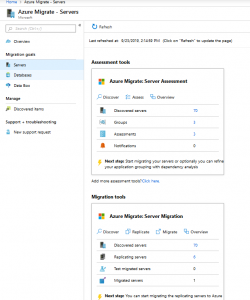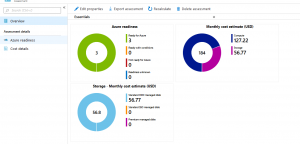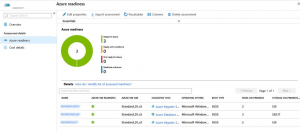- Will my applications run in the cloud?
- What size servers do I need?
- How much will it cost?
- Do I even know where all my applications are?
If you got this far in your planning and then felt “stuck,” I have good news. You can use Azure Migrate, a sweet Azure tool, to move your applications, websites and databases to the cloud.
Solutions not Platforms
Three or four years ago, Microsoft invited me to Seattle to meet with their Azure team. They wanted to hear from people like CGNET (and others) who were out trying to sell and install Azure. What could they do to make things easier? How could Microsoft make Azure more commercially appealing? The clear answer we gave them was this: focus on solutions, not just the platform.
Fortunately, Microsoft heard the message. Yes, they’ve added platform capabilities, such as containers, to Azure. But they’ve also added many solutions. One of these solutions was Azure Site Recovery. This solution lets you create an entire backup site—servers, applications and data—that you can power up if your existing site dies.
Why We Like Using Azure Migrate
Microsoft discovered that they could tease out and repackage some components of Azure Site Recovery that focused just on the cloud migration tasks. Voila, Azure Migrate was born.
Azure Migrate provides the tools that will help you move through a typical migration workflow. Most of these tools were developed by Microsoft. Others are from Independent Software Vendors (such as Carbonite) that provide one or more migration functions.
Let’s look at these typical workflows and how Azure Migrate can help.
Azure Migrate Server Assessment and Migration
The first step in using Azure Migrate is discovery and assessment. The tool will go out and discover on-premises VMware VM’s and Microsoft Hyper-V VM’s. Azure Migrate uses a small appliance to find your VM’s, gather performance data from them, and send the information to Azure for processing.
The output of the tool is a readiness assessment that tells you if your VM’s are ready for migration or not. The tool uses the data it collected to configure the size of an Azure VM that will be needed and estimate its operating costs. The tool will also identify any cross-server dependencies and suggest the best sequence for migrating these servers.
Once the assessment is completed, you can use Azure Migrate to move the VM’s to Azure. You can perform the migration without prior assessment, but I wouldn’t recommend that (unless you like performing on the high wire without a net).
Azure Database Assessment and Migration
With this tool, you use Azure Migrate to assess the readiness of your database for migration. The tool will identify any blocking issues, such as use of SQL features that aren’t supported in Azure. In a nice twist, the tool will also help you understand which migration target is best (for example, SQL Server on Azure vs. Azure SQL DB). It will also let you know about Azure SQL features that might prove useful in your application.
Azure Web App Assessment and Migration
This may be more of a minor addition, but you can use Azure Migrate to assess and migrate on-premises websites to Azure, if the websites are based on .NET or PHP.
Azure Migrate in Action
We are working with a customer who had exactly the unknowns we listed at the top of this post. We were able to use Azure Migrate to first discover all the virtual machines and place them into migration groups. The tool found six VM’s, which we placed into two groups (based on application dependencies). We also created a third test group.

Once we completed that step, we could use Azure Migrate to assess the readiness of their virtual machines. As you can see, the tool estimated storage and compute costs for the three server groups in Azure.

The tool provided further details on how the Azure server configuration components contributed to the monthly cost.

Working with our customer, we have been able to use Azure Migrate to go through the entire migration process; we’re currently readying to complete the migration. Once we complete this migration, the customer will be much further along in moving all or nearly all its workloads to the cloud. We’ve had to do some work with the servers to confirm that they would pass the Azure Migrate assessment. Now, we’re ready to use Azure Migrate to complete the migration.
We like the automation in Azure Migrate. Even more than that, we like the structured process that using Azure Migrate enables. If you’re feeling stuck about moving applications and databases to the cloud, using Azure Migrate might help get you unstuck!





0 Comments